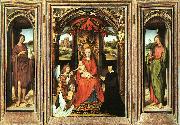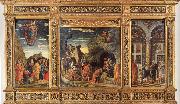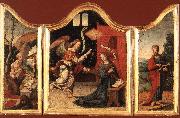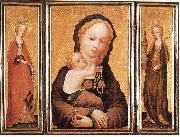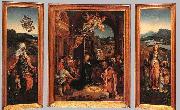
|
Hans Memling
|
|||
|
|
|||
| Netherlandish Northern Renaissance Painter, ca.1435-1494 Born in Seligenstadt, near Frankfurt in the Middle Rhein region, it is believed that Memling served his apprenticeship at Mainz or Cologne, and later worked in the Netherlands under Rogier van der Weyden (c. 1455?C1460). He then went to Bruges around 1465. There is an apocryphical story that he was a wounded at the Battle of Nancy, sheltered and cured by the Hospitallers at Bruges, and that to show his gratitude he refused payment for a picture he had painted for them. Memling did indeed paint for the Hospitallers, but he painted several pictures for them, in 1479 and 1480, and it is likely that he was known to his patrons of St John, prior to the Battle of Nancy. Memling is connected with military operations only in a distant sense. His name appears on a list of subscribers to the loan which was raised by Maximilian I of Austria, to defend against hostilities towards France in 1480. In 1477, when he was incorrectly claimed to have been killed, he was under contract to create an altarpiece for the gild-chapel of the booksellers of Bruges. This altarpiece, under the name of the Seven Griefs of Mary, is now in the Gallery of Turin. It is one of the fine creations of his more mature period. It is not inferior in any way to those of 1479 in the hospital of St. John, which for their part are hardly less interesting as illustrative of the master's power than The Last Judgment which can be found since the 1470s in the St. Mary's Church, Gda??sk. Critical opinion has been unanimous in assigning this altarpiece to Memling. This affirms that Memling was a resident and a skilled artist at Bruges in 1473; for the Last Judgment was undoubtedly painted and sold to a merchant at Bruges, who shipped it there on board of a vessel bound to the Mediterranean, which was captured by Danzig privateer Paul Beneke in that very year. This purchase of his pictures by an agent of the Medici demonstrates that he had a considerable reputation. | |||
|
|
|||
|
Triptych Hans Memling37.jpg Painting ID:: 2953 |
1485 Art History Museum, Vienna | ||
|
|
|||
|
Andrea Mantegna
|
|||
|
|
|||
| Italian 1431-1506 Andrea Mantegna Locations Mantegna was born in Isola di Carturo, close to Padua in the Republic of Venice, second son of a carpenter, Biagio. At the age of eleven he became the apprentice of Francesco Squarcione, Paduan painter. Squarcione, whose original vocation was tailoring, appears to have had a remarkable enthusiasm for ancient art, and a faculty for acting. Like his famous compatriot Petrarca, Squarcione was something of a fanatic for ancient Rome: he travelled in Italy, and perhaps Greece, amassing antique statues, reliefs, vases, etc., forming a collection of such works, then making drawings from them himself, and throwing open his stores for others to study. All the while, he continued undertaking works on commission for which his pupils no less than himself were made available. San Zeno Altarpiece, (left panel), 1457-60; San Zeno, VeronaAs many as 137 painters and pictorial students passed through Squarcine's school, which had been established towards 1440 and which became famous all over Italy. Padua was attractive for artists coming not only from Veneto but also from Tuscany, such as Paolo Uccello, Filippo Lippi and Donatello. Mantegna's early career was shaped indeed by impressions of Florentine works. At the time, Mantegna was said to be a favorite pupil; Squarcione taught him the Latin language, and instructed him to study fragments of Roman sculpture. The master also preferred forced perspective, the lingering results of which may account for some Mantegna's later innovations. However, at the age of seventeen, Mantegna separated himself from Squarcione. He later claimed that Squarcione had profited from his work without paying the rights. His first work, now lost, was an altarpiece for the church of Santa Sofia in 1448. The same year Mantegna was called, together with Nicol?? Pizolo, to work with a large group of painters entrusted with the decoration of the Ovetari Chapel in the apse of the church of Eremitani. It is probable, however, that before this time some of the pupils of Squarcione, including Mantegna, had already begun the series of frescoes in the chapel of S. Cristoforo, in the church of Sant'Agostino degli Eremitani, today considered his masterpiece. After a series of coincidences, Mantegna finished most of the work alone, though Ansuino, who collaborated with Mantegna in the Ovetari Chapel, brought his style in the Forl?? school of painting. The now censorious Squarcione carped about the earlier works of this series, illustrating the life of St James; he said the figures were like men of stone, and had better have been colored stone-color at once. This series was almost entirely lost in the 1944 Allied bombings of Padua. The most dramatic work of the fresco cycle was the work set in the worm's-eye view perspective, St. James Led to His Execution. (For an example of Mantegna's use of a lowered view point, see the image at right of Saints Peter and Paul; though much less dramatic in its perspective that the St. James picture, the San Zeno altarpiece was done shortly after the St. James cycle was finished, and uses many of the same techniques, including the classicizing architectural structure.) San Luca Altarpiece, 1453; Tempera on panel; Pinacoteca di Brera, MilanThe sketch of the St. Stephen fresco survived and is the earliest known preliminary sketch which still exists to compare to the corresponding fresco. Despite the authentic look of the monument, it is not a copy of any known Roman structure. Mantegna also adopted the wet drapery patterns of the Romans, who derived the form from the Greek invention, for the clothing of his figures, although the tense figures and interactions are derived from Donatello. The drawing shows proof that nude figures were used in the conception of works during the Early Renaissance. In the preliminary sketch, the perspective is less developed and closer to a more average viewpoint however. Among the other early Mantegna frescoes are the two saints over the entrance porch of the church of Sant'Antonio in Padua, 1452, and an altarpiece of St. Luke and other saints (at left) for the church of S. Giustina, now in the Brera Gallery in Milan (1453). As the young artist progressed in his work, he came under the influence of Jacopo Bellini, father of the celebrated painters Giovanni and Gentile, and of a daughter Nicolosia. In 1453 Jacopo consented to a marriage between Nicolosia to Mantegna in marriage. | |||
|
|
|||
|
Triptych new3/Andrea Mantegna-477646.jpg Painting ID:: 29793 |
mk67 Tempera on panel 33 7/8x63 9/16in | ||
|
|
|||
|
unknow artist
|
|||
|
|
|||
|
|
|||
|
Triptych new4/unknow artist-435937.jpg Painting ID:: 32200 |
Panel Museo Cerralbo, Madrid | ||
|
|
|||
|
MASTER of Saint Veronica
|
|||
|
|
|||
| German Gothic Era Painter, active ca.1395-1420 | |||
|
|
|||
|
Triptych new4/MASTER of Saint Veronica-582465.jpg Painting ID:: 32425 |
1400-15 Tempera on wood, 58,9 x 39,5 cm | ||
|
|
|||
|
BEER, Jan de
|
|||
|
|
|||
| Netherlandish Painter, ca.1475-1528 South Netherlandish painter and draughtsman. He is first mentioned in 1490 in the register of the Antwerp Guild of St Luke, apprenticed to the painter Gillis van Everen ( fl 1477-1513). In 1504 de Beer became a master. He subsequently served as alderman of the guild in 1509 and dean in 1515, although he found himself temperamentally unsuited to the position of dean, as is known from a lawsuit he filed in 1519 regarding guild administration. This document also reveals that de Beer participated in the preparations for Charles V's 'Joyous Entry' into Antwerp in 1515 and for the Antwerp Society of Rhetoricians' entry that year in the Malines landjuweel (regional competition of the rhetoricians). In 1510 and 1513 de Beer enrolled apprentices; his son Aert de Beer (c. 1509-before 6 Aug 1540) became an Antwerp master in 1529. The artist is undocumented between 1519 and 1528, by which date he was dead. In 1567 Guicciardini included de Beer in his list of famous Netherlandish painters. | |||
|
|
|||
|
Triptych new21/BEER, Jan de-798886.jpg Painting ID:: 62384 |
76,4 x 24,5 cm (each wing) Wallraf-Richartz Museum, Cologne Jan de Beer was a Flemish painter, one of the Antwerp Mannerist school many of whose paintings were formerly ascribed to him. The central panel depicts the Adoration of the Shepherds. On the left wing is St Felicity with her sons and on the right is St Ursula with her followers. The composition and style are characteristic of Antwerp Mannerism of the early 16th century. Author: BEER, Jan de Title: Triptych , 1501-1550 , Flemish Form: painting , religious | ||
|
|
|||
|
Also Buy::. For Following Paintings / Artists / Products, Please Use Our Search Online: |






